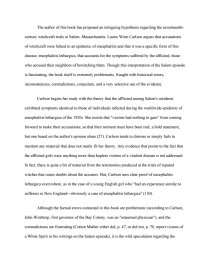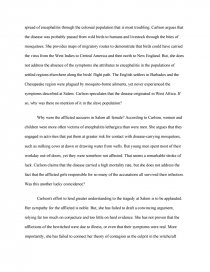The Fever of Salem
Essay by review • February 26, 2011 • Book/Movie Report • 658 Words (3 Pages) • 1,223 Views
The author of this book has proposed an intriguing hypothesis regarding the seventeenth-century witchcraft trials in Salem, Massachusetts. Laurie Winn Carlson argues that accusations of witchcraft were linked to an epidemic of encephalitis and that it was a specific form of this disease, encephalitis lethargica, that accounts for the symptoms suffered by the afflicted, those who accused their neighbors of bewitching them. Though this interpretation of the Salem episode is fascinating, the book itself is extremely problematic, fraught with historical errors, inconsistencies, contradictions, conjecture, and a very selective use of the evidence.
Carlson begins her study with the theory that the afflicted among Salem's residents exhibited symptoms identical to those of individuals infected during the worldwide epidemic of encephalitis lethargica of the 1920s. She insists that "victims had nothing to gain" from coming forward to make their accusations, so that their torment must have been real; a bold statement, but one based on the author's opinion alone (27). Carlson tends to dismiss or simply fails to mention any material that does not neatly fit her theory. Any evidence that points to the fact that the afflicted girls were anything more than hapless victims of a virulent disease is not addressed. In fact, there is quite a bit of material from the testimonies produced at the trials of reputed witches that raises doubts about the accusers. But, Carlson sees clear proof of encephalitis lethargica everywhere, as in the case of a young English girl who "had an experience similar to sufferers in New England---obviously a case of encephalitis lethargica" (130).
Although the factual errors contained in this book are problematic (according to Carlson, John Winthrop, first governor of the Bay Colony, was an "esteemed physician"), and the contradictions are frustrating (Cotton Mather either did, p. 47, or did not, p. 70, report visions of a White Spirit in his writings on the Salem episode), it is the wild speculation regarding the spread of encephalitis through the colonial population that is most troubling. Carlson argues that the disease was probably passed from wild birds to humans and livestock through the bites of mosquitoes. She provides maps of migratory routes to demonstrate that birds could have carried the virus from the West Indies to Central America and then north to New England. But, she does not address the absence of the symptoms
...
...


